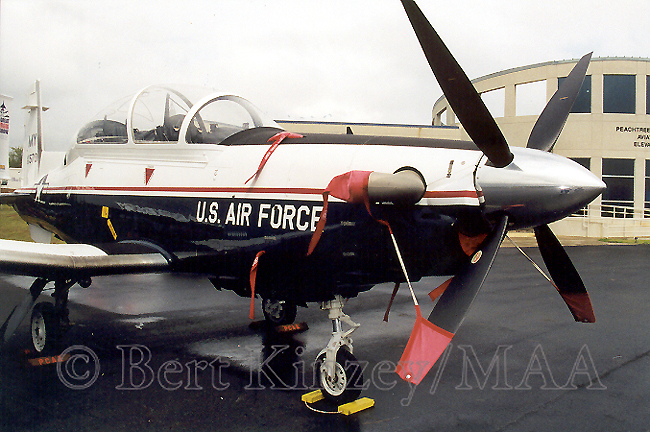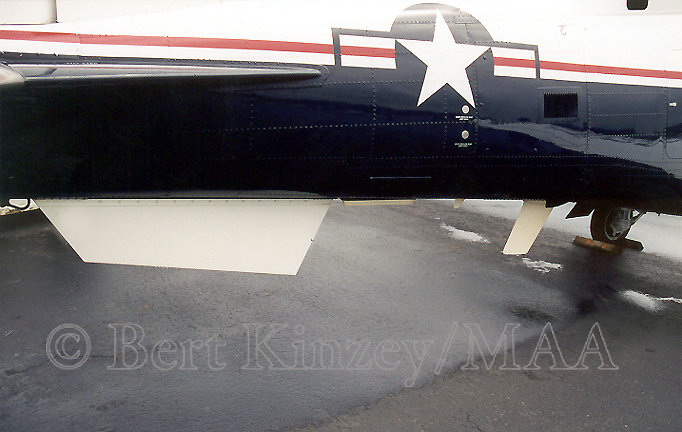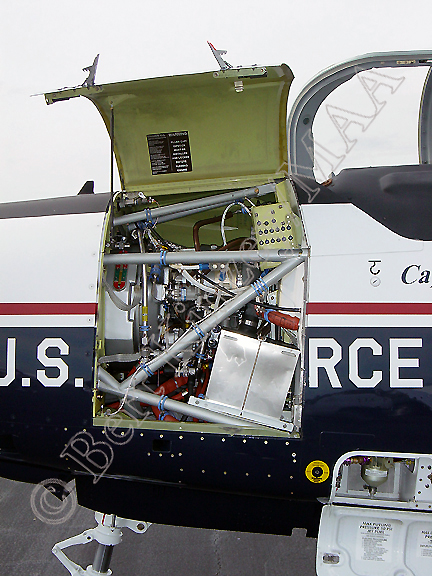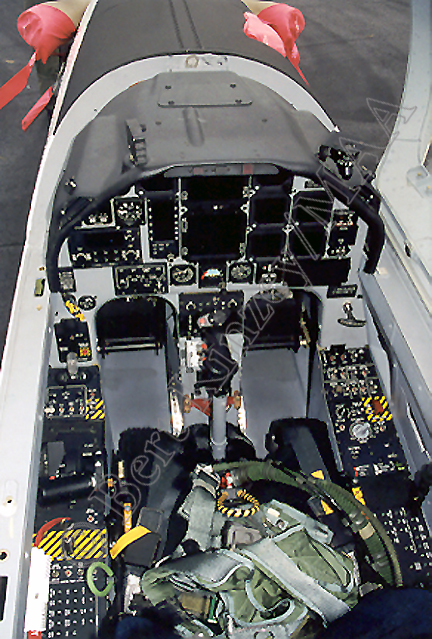T-6 Texan II Information File:
Designated and named after the famous North American T-6 Texan trainer of World War II fame (designated SNJ by the U. S. Navy), the T-6 Texan II carries on in the tradition of its namesake by serving as a primary training aircraft for the U. S. Air Force and the U. S. Navy as well as several foreign nations. It is produced by Raytheon Aircraft and is based on Raytheon’s Beech/Pilatus PC-9 Mk II. It was the winner of the aircraft portion of the Joint Primary Aircraft Training System (JPATS) competition in the 1990s, which was held to find a single replacement aircraft for the U. S. Air Force’s T-37 Tweet and the Navy’s T-34C Turbo Mentor. JPATS also includes a suite of simulators, training devices, computer-aided academics, and a training integration management system.
The T-6A began developmental flight testing in July 1998. It was approved for certification and production in July 1999, and a full rate production decision was made in December 2001. The first T-6As became operational with the USAF at Moody Air Force Base in 2001. The first T-6A became operational with the Navy in 2003 at NAS Pensacola, Florida. Since then, the T-6A completely replaced the T-37 in the USAF by 2010, but the Navy’s transition from the T-34C to the T-6 Texan II is still continuing as of this posting in July 2011. In addition to training pilots, the T-6 Texan II is used for training Naval Flight Officers in the Navy.
Called the CT-156 Harvard II by the Canadian Forces, the aircraft also carries on the Harvard name applied to the original T-6 by the British and Canadians. It is also flown by the Luftwaffe, the Greek Air Force, the Israeli Air Force, the Iraqi Air Force, and the Royal Moroccan Air Force.
Like its predecessor, the T-6 Texan II is a single engine, two-seat trainer with the pilot and instructor sitting in tandem under a single enclosure. The original T-6 used a Pratt & Whitney R-1340-AN-1 Wasp radial engine that produced 550 horsepower. Again, the Texan II follows in the footsteps of the original and is likewise powered by a Pratt & Whitney engine, but in this case it is PT-6A-68 turboprop powerplant that develops 1,100 horsepower. The aircraft is fully aerobatic and has a pressurized cockpit equipped with Martin-Baker ejection seats.
The initial training version was the T-6A. The T-6B followed and is an upgraded T-6A with a digital glass cockpit including a Head-Up Display and multi-function displays. It also has a Hands On Throttle and Stick (HOTAS) system. The T-6C is a T-6B with hardpoints under the wings, and there are several other attack versions built or under evaluation for the light attack or counter insurgency (COIN) role.
T-6A Texan II Data
Length: 33.4 feet
Wingspan: 33.5 feet
Height: 10.7 feet
Weight (empty) 5,000 pounds
Weight (gross) 6,500 pounds
Maximum Airspeed 320 miles-per-hour
Ceiling 31,000 feet
Range 900 nautical miles
Rate of Climb 3,100 feet per minute
T-6 Texan II, T-6A Cockpit Detail Photos:
The photographs in this set were taken in the cockpits of a U. S. Air Force T-6A Texan II and provide a complete and detailed look at the modern displays, controls and Martin-Baker ejection seats. All are Detail & Scale copyright photographs taken by Bert Kinzey.































